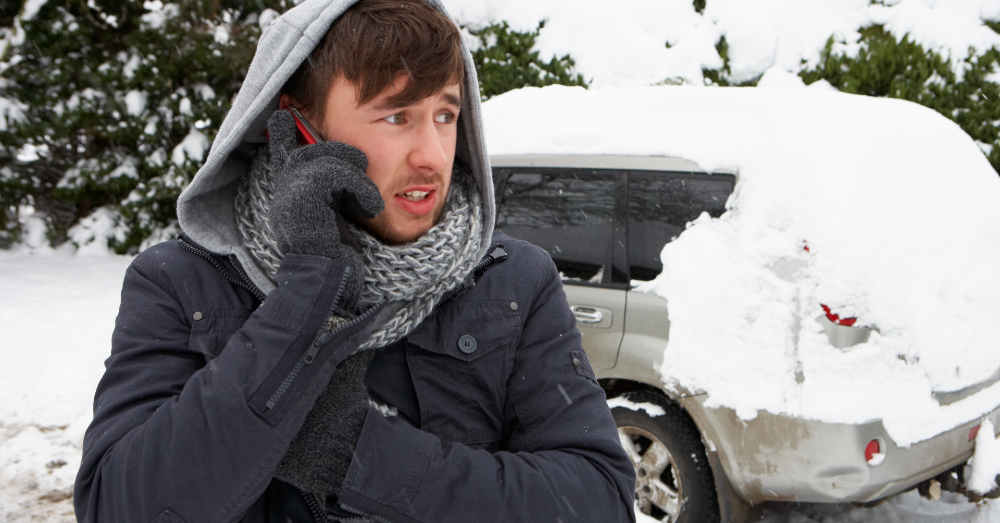When the mercury falls below zero, most items, don’t want to work. If you don’t protect your car, you might not make it where you want to go.
Everything in your car must work harder when the temps drop to extremely cold levels. It takes more power from your battery to get things moving, some fluids could freeze up, and some of the moving parts in your car might not move as well until they are warmed up. It’s important to know how to handle some of the problems facing you when these cold temps arrive.
1. You need to know how to jump-start a car
Your battery has a much harder time getting the car started when the weather is extremely cold. If your battery is already nearing the end of its life, you might need to jump-start your car from another to go where you need to. Make sure you know how to attach the cables and what should be done to get your battery juiced up and going again. If this happens to you, it’s a good idea to have the battery checked before you need a second jump-start.
2. It’s important to understand EV driving range in the cold
Every vehicle loses some of its driving range when the temperatures fall, but there aren’t EV charging stations on every corner yet. In order to protect your car and yourself in these extreme temps, it’s important you know that your electric vehicle will lose as much as 40 percent of the driving range. This means you should plan ahead for your drives. It’s a good idea to precondition your vehicle before driving and keep it plugged in whenever you’re not driving to maintain as much of the driving range as possible.
3. Don’t let your tires go flat
When the temperatures drop, the air pressure in your tires becomes less and less. This means you might need to add air more often than you normally would. Check your tire pressure at least once a week during extreme cold spells. This will help ensure you don’t have underinflated tires. Incidentally, the same goes true for extremely hot temps where you might need to let some air out because the tires become overinflated.
4. Your oil could be much thicker than normal
Most of us don’t think about changes to the internal components of our cars when it gets extremely cold out. When the temperature drops to about 20 degrees below zero, oil becomes thick and hard for the oil pump to pick up and circulate. If you use synthetic oil or a low-viscosity oil, this shouldn’t happen. If you’re using a high-viscosity oil, one way to protect your car is to switch to a lower viscosity during these extreme cold spells.
5. Have you got ice in your fuel line?
Gasoline doesn’t freeze until the temperature reaches 100 degrees below zero. That said, there can be moisture in your gas line, and this can become icy and freeze. The best way to keep ice out of your fuel line is to keep your car at least half full during cold spells. Treat that half-full mark as the empty line, and you won’t have this problem at all.
6. Are the electronics malfunctioning?
When it’s extremely cold out, some of the electronics, especially LCD screens, might not function properly. This can be frustrating, but unless you need the navigation system to get where you need to go, you can live without some of the electronics during your drive. There isn’t much you can do about this problem except wait for the car to warm up and these items to begin working. If you want to avoid this issue, install an engine-block heater to protect your car and speed up the process.
7. Should you use the wiper blades to help remove ice and snow?
Unless you want your next stop to be at the store to buy a set of new wiper blades, don’t use them to remove ice and snow from your windshield. In these extreme cold temperatures, the rubber can become brittle, crack, and tear. If you use these items to remove the ice and snow, you’re exacerbating the situation. Instead, use an ice scraper and let the blades warm up naturally. You’ll need them to function properly if it begins to snow or warms up and you’re faced with slush and rain.
8. Is your windshield frozen on the inside?
Typically, the defrost and heating functions of our cars take care of the interior side of the windows to give us a clear view. If you accidentally leave the windows down, even a little bit, the interior could frost over like the outside. If you can’t get the windshield defrosted because these car functions aren’t working, you’ll need to use a heat source, such as a hair dryer, to remove the interior frost. Take your car to a repair shop and let them check the heating and defrost functions for you. This could be a serious safety problem.
9. Your antifreeze lets you down
Before you need the antifreeze to work for you, it’s important to protect your car by understanding the need to mix your coolant with water. When you put 100 percent antifreeze in your car, it has a higher freeze point than when it’s mixed. Most newer models have extended-life coolant, but if you haven’t checked your antifreeze in a while, you should check it and possibly replace it to ensure it’s effective against extreme cold temperatures.
10. Have you been bitten by “Snow Snakes”
One of the toughest lessons to learn is to check your belt before the cold temperatures arrive. Most of us learn this when the belt breaks while trying to start the car in extremely cold temps. This typically only happens with belts that are brittle, old, and worn. That cold temperature, coupled with the car trying to start, do these belts in and breaks them. Next time, check your belt when you know the cold is coming.
Some might have already experienced a few of these problems, but others could benefit from these tips to protect your car against cold temps. Keep in mind the best way to beat the cold is to keep your car in a garage and out of the elements.




